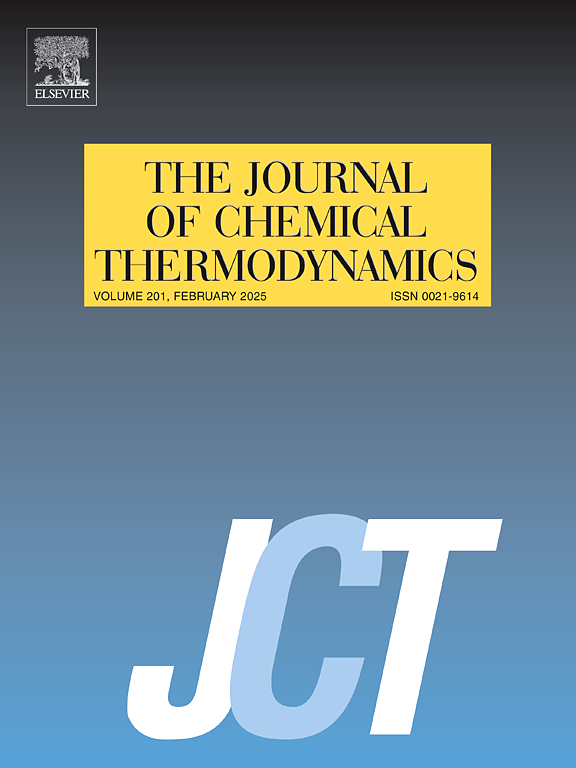Density, viscosity, ultrasonic and thermoacoustic studies of aqueous nicotinamide (Vitamin B3) binary mixtures: Temperature dependence
IF 2.2
3区 工程技术
Q3 CHEMISTRY, PHYSICAL
引用次数: 0
Abstract
The density () and ultrasonic velocity () measurements were performed for nicotinamide (Vitamin B3) in a water medium with various concentrations (0.101 to 1.111) mol·kg−1 in the temperatures range of 298.15 K to 323.15 K. Experimental data is used to estimate volumetric parameters such as apparent molar volume (), partial molar volume (), thermoacoustic parameters like adiabatic compressibility (), acoustic impedance (), intermolecular free length (), ultrasonic attenuation (), relative association (RA), relaxation time (), and internal pressure (). In addition, thermodynamic parameters such as Gibbs free energy (), Enthalpy (), and Entropy () are also evaluated to interpret the molecular interaction in the medium. The single-point energy calculation is also determined in a gaseous state and an aqueous medium using the IEFPCM model at HF, DFT/B3LYP, and MP2 methods using 6-311G ++(d,p) basis set to estimate the strength of the hydrogen bond. The results are interpreted in terms of structure-making or structure-breaking effects of drug molecules in the mixtures.

烟酰胺(维生素B3)二元混合物的密度、粘度、超声和热声研究:温度依赖性
在298.15 ~ 323.15 K温度范围内,测定了烟酰胺(维生素B3)在不同浓度(0.101 ~ 1.111)mol·kg−1的水介质中的密度(ρ)和超声速度(u)。利用实验数据估计表观摩尔体积(VΦ)、偏摩尔体积(V∅o)等体积参数,热声参数如绝热压缩系数(β)、声阻抗(Z)、分子间自由长度(Lf)、超声衰减(αf2)、相对关联(RA)、弛豫时间(τ)、内压(π)等。此外,热力学参数,如吉布斯自由能(ΔG),焓(ΔH)和熵(ΔS)也进行了评估,以解释分子在介质中的相互作用。用IEFPCM模型在HF、DFT/B3LYP和MP2方法下确定了气态和水介质下的单点能量计算,使用6- 311g++ (d,p)基集来估计氢键强度。这些结果是根据混合物中药物分子的结构形成或结构破坏效应来解释的。
本文章由计算机程序翻译,如有差异,请以英文原文为准。
求助全文
约1分钟内获得全文
求助全文
来源期刊

Journal of Chemical Thermodynamics
工程技术-热力学
CiteScore
5.60
自引率
15.40%
发文量
199
审稿时长
79 days
期刊介绍:
The Journal of Chemical Thermodynamics exists primarily for dissemination of significant new knowledge in experimental equilibrium thermodynamics and transport properties of chemical systems. The defining attributes of The Journal are the quality and relevance of the papers published.
The Journal publishes work relating to gases, liquids, solids, polymers, mixtures, solutions and interfaces. Studies on systems with variability, such as biological or bio-based materials, gas hydrates, among others, will also be considered provided these are well characterized and reproducible where possible. Experimental methods should be described in sufficient detail to allow critical assessment of the accuracy claimed.
Authors are encouraged to provide physical or chemical interpretations of the results. Articles can contain modelling sections providing representations of data or molecular insights into the properties or transformations studied. Theoretical papers on chemical thermodynamics using molecular theory or modelling are also considered.
The Journal welcomes review articles in the field of chemical thermodynamics but prospective authors should first consult one of the Editors concerning the suitability of the proposed review.
Contributions of a routine nature or reporting on uncharacterised materials are not accepted.
 求助内容:
求助内容: 应助结果提醒方式:
应助结果提醒方式:


